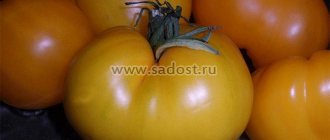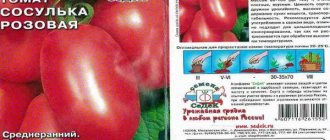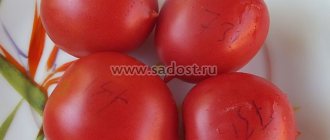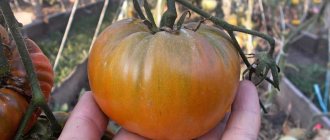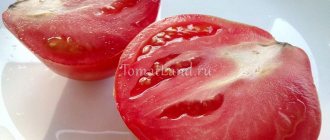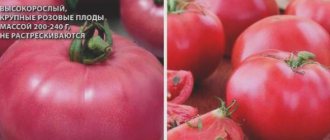Vegetable growing » Tomatoes
1
2032
Article rating
Kira Stoletova
The Kapia rosea tomato is one of the most common varieties of tomato vegetables. Experts have included it in the top ten best types of tomatoes. This is a universal species that can be grown in all regions, with any climatic conditions. As soon as the summer season begins, gardeners ardently buy up all the seeds of this variety.
Description of tomato Capia rosea
Characteristics of the variety
The Kapiya variety was bred by Russian breeders. In 1997 it was included in the State Register of the Russian Federation. During all the research on the characteristics of the variety, it showed amazing quality results.
Kapia tomatoes can be grown in all regions of the country. Depending on the climate zone, the method of cultivation is determined. For example, in an area with a warm climate, planting in open areas is possible. If the weather conditions are cool, then the plant should be planted only in greenhouses.
Description of the bush
Pink Capia is a high-yielding species. From 1 bush it is possible to collect about 5 kg of selected tomatoes (about 14 kg of fruits are collected from 1 m2). The plant matures in an average amount of time. The duration of the growing season, from the moment the first shoots appear, is about 100 days.
The bushes have power and abundant foliage. The height of the main stem reaches a height of 2-2.5 m. The leaves are presented in an elongated shape. There are small carved patterns on their surface. The leaves are colored in dark shades of green.
It is best to grow a plant with 2-3 stems, so the bush should be formed regularly. It is possible to form several nodes in one sinus.
Description of the fruit
The Kapija rosea tomato has a cylindrical shape. There is a small pointed area at the end of the fruit. Some often pay attention to the fact that it looks like a drop of water. The description and characteristics of the variety indicate that the surface is not very ribbed and there are about 5-7 bumps.
The color of the fruit is bright, rich pink. It is important to note that there is no staining or discoloration at the base. The weight of an individual fruit is about 140-160 g. The weight of ripened fruits is uniform throughout the entire area of the bush.
Tomatoes of this type have a pleasant sweetish taste, with a small amount of sourness. The pulp is dense and juicy, but not watery. The amount of dry matter reaches 6-7%. These tomatoes are universal in use. They can be eaten raw, prepared in salads or preserved for the winter season. Quite often these fruits are frozen. It is believed that, in this way, more nutrients and beneficial substances are retained in the fruits.
Reviews
Antonina, 52 years old:
“The unusual shape of the fruit immediately attracted my attention. I decided to purchase seeds, and have never regretted it. The seeds have good germination. The technology for growing Kapiya pink tomato is no different from other varieties. The yield is excellent; from 1 bush we managed to collect up to 5 kg of crop. I made juice and paste from the fruits, and even froze some tomatoes.”
Vasily, 61 years old:
“I grew the Kapia rosea tomato in greenhouse conditions. The bushes are tall, about 2 m. The variety is productive, the tomatoes are tasty and sweet. I was especially pleased with the culture’s resistance to disease. There were no difficulties in growing tomatoes.”
The fruits are distinguished by their appearance and amazing taste. The popularity of the variety is only increasing every year. Many summer residents note that the variety has many advantages and is capable of producing a good harvest even under unfavorable conditions.
Advantages and disadvantages
The variety is resistant to diseases
When considering the description of the variety, we can highlight a whole set of its positive qualities:
- versatility in use and preparation;
- high yield rates;
- unique presentation;
- possibility of long-term storage and transportation;
- disease resistance;
- resistance to temperature changes.
Description of the tomato Kapiya pink and its characteristics, features of the variety
The pink Kapija tomato, reviews of which indicate the possibility of using the fruit for preparing various dishes, freezing and canning in its own juice, can be grown both in a greenhouse and in open ground. This tomato variety has an unusual shape, intense pink color and excellent taste.
Characteristics of the variety
The Kapiya pink tomato variety is a variety with an average fruit ripening period. The description of the variety is related to the characteristics of its cultivation. The plant is cultivated in open ground and under film covers. In areas with a short summer period, tomatoes are grown in greenhouses.
The yield of the variety reaches 10 kg per 1 m². Considering the density of plants per unit area, an average of 4 kg of tomatoes are harvested from a bush. Fruit ripening occurs 110 days after the appearance of the first shoots.
From seedlings grown in seedlings, powerful bushes are formed, reaching a height of 2 m. High productivity is ensured by the formation of 2-3 branches from the main stem.
As you can see in the photo, tomatoes grow in clusters, and the load on the plant is distributed evenly. Tall bushes require additional support and garter, otherwise the stem may become deformed under the weight of ripe tomatoes.
The leaves of this variety of tomato are elongated in shape, with a carved surface. The foliage color is intense green. The culture is resistant to diseases.
The characteristics of the fruit are associated with an elongated shape, resembling a drop in appearance. The surface of the tomatoes is slightly ribbed; when cut horizontally, 5 seed chambers are observed.
The color of the variety is bright pink, there is no spot near the stalk. The weight of the tomato reaches 150 g. Up to 10 fruits ripen on 1 bunch. The tomato pulp is juicy, soft, and pleasant to the taste.
Sowing seeds for seedlings is carried out 2 months before the planned planting in the ground. Growing planting material requires maintaining temperature conditions, timely watering and fertilizing.
In the phase of formed 2 true leaves, a dive is carried out. For planting seedlings, choose well-lit places. It is recommended to consider crop rotation when choosing a location for tomatoes.
The best predecessors of culture are:
- zucchini;
- cucumbers;
- dill;
- carrot.
Before planting, the soil is loosened, weeds are removed, and organic fertilizer is added to the holes made. The choice of time to plant seedlings and the method of cultivating the variety depends on the climatic conditions of the region.
The plant is intended for cultivation in open ground, but in the northern regions it is better to plant in greenhouses.
High yields are achieved by following the rules of crop care. With the right approach, fresh tomatoes can be enjoyed throughout the entire fruiting period.
Growing rules
First of all, it is recommended to plant the seeds. Greenhouses are used for this. Seeds are planted 45-60 days before planting in open ground conditions. After the seedlings are ready for planting, you should begin choosing the soil. Firstly, it must contain a minimum amount of acids and alkalis. Secondly, it is important that it is located in open areas where sunlight will flow without problems.
Planting in open ground is carried out at the moment when the soil warms up to a temperature of 16°C. It is also recommended to loosen the soil so that a sufficient amount of oxygen penetrates into it. It is necessary to remove all weeds and other foreign objects so as not to block the development of the root system. If you live in the southern region, then planting can be done in early May. If your region of residence is the northern part of the country, then it is better to wait until June.
When planting, you should maintain a distance of 50-60 cm. But between the holes it should be about 40 cm. The planting depth is 2 cm, so that the seedlings form faster and accelerate their growth. There should be no more than 4 plants per 1 m2.
Growing and care
In regions with a cool climate and when there is a risk of frost, bushes are planted in greenhouse conditions (tall plants are placed in the central rows). If you organize the space correctly, the crop is harvested twice per season.
For mass planting, 2 main trunks are formed, the bushes are pruned once every 2 weeks. At the same time they are tied to the supports.
Agricultural conditions:
- systematic watering - 3-4 times a week (norm per 1 sq. m - 6-9 l);
- fertilizing begins 2 weeks after planting (use nitroammophosphate, urea, saltpeter, superphosphate);
- foliar irrigation for nutritional purposes;
- Hilling up bushes and mulching beds with a layer of up to 10 cm.
Care
The principle of care is to regularly loosen and fertilize the soil and water the plant. Loosening the soil and removing all weeds should be done once every two weeks. You should also weed the beds every week to prevent the soil from forming a crust. Watering should be carried out only by the drip method and exclusively with water at room temperature. This will allow the root system not to become overcooled.
Fertilizing soil and seedlings can be carried out using several methods:
- The first is to use organic fertilizers. To do this, it is recommended to use humus, liquid cow or bird droppings, as well as wood ash.
- The second method is to use minerals. It is best to choose those options that contain a high concentration of potassium, phosphorus or nitrogen. This will increase the yield level.
Tomato Kapija pink: characteristics and description of the variety, growing features
The tomato Kapija rosea has not left summer residents indifferent for a long time. The variety is considered one of the most common and is suitable for growing in any climatic conditions.
Reviews about the Kapija rosea tomato are only positive. The fruits are used to prepare various dishes. Can be used for canning and preparing tomato juice.
Tomatoes have an unusual size, bright colors and amazing taste.
Description of the variety
The tomato Kapiya pink is considered a mid-season variety. The ripening period is 115 days. You can grow tomatoes both in open ground and in a greenhouse. The plants are tall, their height is approximately 2 m. The fruits are pepper-shaped and bright pink in color. The weight of the tomato is at least 150 grams.
Note! The variety is high-yielding. From 1 bush you can collect up to 5 kg of fruits
Advantages and disadvantages
When studying the Capia rosea tomato, you can note a whole list of advantages. The main ones are:
- universal use;
- high productivity;
- fruits can be stored for a long time and can easily be transported;
- resistance to diseases and adverse weather conditions.
Features of cultivation
Tomatoes are capricious crops. To reap a good harvest, you need to follow the growing technology. First of all, preparations should be made:
- Preparation of planting material. For sowing, you should choose only high-quality seeds. In addition, they need to be tested for germination. To do this, the seeds should be poured into a container with salted water for 2 hours. The seeds that sink to the bottom are complete. They can be used for sowing. Instances that rise to the surface should be removed.
- Soil preparation. Tomatoes prefer to grow in fertile soil. It is advisable to purchase soil in a specialized store.
- Preparing containers. You can select any containers for growing seedlings. The main thing is that they have a drainage hole.
Important! Since seedlings have a negative attitude towards picking, it is advisable to plant the seeds in peat cups. The process of sowing seeds is simple
The boxes need to be filled with earth, the seeds distributed, and sprinkled with soil. Cover the top of the crops with glass and place the containers in a warm place
The process of sowing seeds is simple. The boxes need to be filled with earth, the seeds distributed, and sprinkled with soil. Cover the top of the crops with glass and place the containers in a warm place.
Planting seedlings in the ground
The Kapija rosea tomato can be grown both in open ground and in protected ground. Seedlings should be planted in the ground no earlier than May. Before engaging in planting work, it is necessary to carry out preparatory measures:
Preparing the bed. Tomatoes prefer to grow in a lighted area
In addition, it is necessary to pay attention to predecessors. Tomatoes should be planted after the following crops: cucumbers, carrots, parsley, zucchini, dill
You should not use peppers, potatoes, or eggplants as predecessors. In addition, the area needs to be cleared of weeds, dug up, and fertilized.
You may be interested in:
For 1 sq. m. It is advisable to plant up to 4 plants. If you place bushes close to each other, they will not be able to develop normally.
Cultivation care
Caring for the Kapia rosea variety is standard. The main care activities are as follows: watering, fertilizing, weeding, loosening the soil, tying and pinching.
- Watering. Plants need to be watered regularly. To do this, it is advisable to use warm water. Watering must be of high quality and timely.
- Loosening the soil and removing weeds. Weeds have a detrimental effect on plants, so you need to get rid of them as they appear. Loosening the soil is also a mandatory procedure; as a result, air will flow to the root system.
- Feeding. Plants must be fed with organic and mineral fertilizers. To do this, it is worth using humus, manure, wood ash, phosphate and nitrogen compounds.
Note! Timely application of fertilizers will increase the yield several times
Diseases and pests
Tomato Capia rosea is resistant to many diseases. However, you should not forget about preventive measures. Bushes must be inspected regularly.
The most common pest is the whitefly. Treating crops with chemicals containing copper will help preserve the harvest.
Diseases and pests
Fortunately, this variety has high immunity to common diseases. Therefore, there is no need for regular spraying. Preventative precautions are not mandatory. The main thing is to regularly monitor the appearance of the bush.
The only possible parasite is the presence of greenhouse whitefly. To combat it, copper-containing preparations are used.
This is a unique variety that is suitable even for beginners. It does not require any maintenance, but this does not prevent you from getting high yields.
Description of the fruit
Pink capia tomatoes have positive characteristics. The fruit is slightly elongated, pointed at the very tip. In appearance it resembles a drop. The fruits are sparsely ribbed, there are up to five nests. Capia has a bright pink color, the color near the stalk is unchanged, there are no spots. The weight of one tomato reaches 150 grams. Up to 10 tomatoes can grow on one branch.
Tomatoes have a pleasant taste. The tomato pulp is juicy and soft. They are consumed fresh and made into salads. A housewife who grew tomatoes on her plot can make preparations for the winter. These tomatoes are ideal for whole-fruit canning.
Capia can be frozen. In this case, it will retain all its taste and beneficial qualities.
